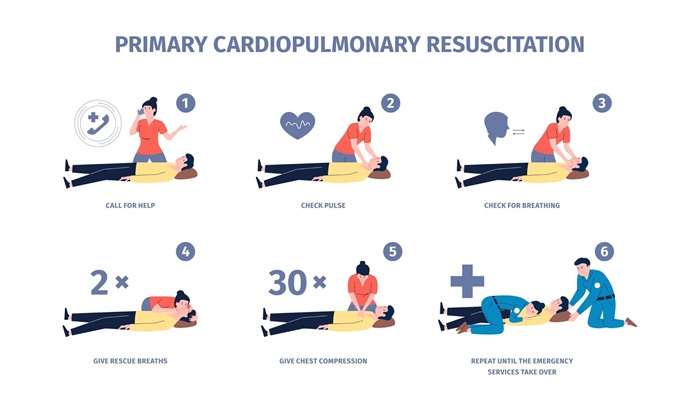In an emergency where an adult’s heart stops, CPR (cardiopulmonary resuscitation) can be a life-saving measure. Knowing the correct CPR procedure, from chest compressions to rescue breaths, can make a significant difference.
To perform CPR on an adult:
Use an AED (Automated External Defibrillator) if available. Only attempt CPR if there’s no other option and immediate help isn’t available. Ideally, a trained professional should perform cardiopulmonary resuscitation for the best results.
Please call an ambulance or take the patient to a hospital where trained emergency doctors and specialists can perform CPR.
Here’s a simple guide to giving CPR to an adult.

When an adult suffers a cardiac arrest, acting quickly and knowing how to perform CPR could mean the difference between life and death. Cardiopulmonary resuscitation helps keep oxygen-rich blood flowing to the brain and other organs until professional medical assistance arrives.
This guide covers the essential CPR steps, including using an AED.
Gently tap the person to check if they’re responsive. If there is no reaction, immediately call emergency services and get ready to begin CPR.
Place the person on their back on a firm, flat surface, ensuring an open airway by tilting their head slightly back and raising their chin.
Position the heel of one hand in the centre of the chest, just below the nipple area. Place your other hand on top, interlocking fingers.
Push hard and fast, using your body weight to compress the chest to a depth of about 2 inches. The CPR compression rate should be around 100-120 compressions per minute.
After every 30 compressions, give two rescue breaths. Pinch the person’s nose shut, take a breath, and create a seal over their mouth to blow in for about one second, watching for chest rise. Continue these cycles of 30 compressions and 2 breaths.
Understanding the CPR procedure is essential. For untrained bystanders, hands-only CPR (chest compressions without rescue breaths) can still be effective. Ensure compressions are continuous, with minimal interruptions, to maximise blood flow.
CPR should be administered if an adult is unresponsive and not breathing normally. If you’re unsure, it’s safer to begin adult CPR rather than delay, as prompt action is critical in cardiac emergencies.
An AED or Automated External Defibrillator is a portable device that checks the heart’s rhythm and can deliver an electric shock to restart it. AEDs are designed for easy use by laypersons and contain instructions for correct placement of pads and shock administration. Using an AED promptly can increase the chances of survival significantly in cases of sudden cardiac arrest.
If you witness someone experience a cardiac event, getting them medical help quickly is essential. For specialised care, head to the Emergency Medicine Hospital in Bangalore, where professionals are equipped to manage critical heart emergencies.
When facing a medical emergency, it’s crucial to seek immediate help from the Best Emergency Care Doctors in Bangalore. Their expertise ensures that you receive the best care during critical situations. Remember, quick and accurate treatment can make all the difference in saving lives. Always prioritize your health and consult top doctors for the best care available.
The person should be laid flat on their back on a firm surface. The head should be tilted back slightly to keep the airway open, with the chin lifted to maintain an unobstructed passage for air.
CPR for adults involves 30 chest compressions followed by 2 rescue breaths. The compression rate should be 100-120 compressions per minute.
CPR should only be stopped when professional help arrives, the person shows signs of life (like breathing), or you are physically unable to continue. If you’re too exhausted to continue, it’s essential to let someone else take over.
While CPR can save lives in many emergency situations, it is important to know when not to perform it. Here are the key instances where CPR should not be administered:
If a person is breathing normally, CPR is not necessary. CPR should only be started if the person is not breathing at all or if their breathing is irregular. In children and infants, CPR is needed if they are not breathing normally.
CPR should only be performed if the person’s heart has stopped beating or if the pulse is absent. If the person has a pulse, performing chest compressions could cause harm.
Before performing CPR, ensure the environment is safe for you and the person in need of help. If you are at risk (e.g., in a traffic accident or near a fire), do not attempt CPR until the area is secure.
If the person regains consciousness, starts breathing, or shows any signs of life, CPR should be stopped immediately. At this point, focus on monitoring the person until professional help arrives.
Categories: Emergency Medicine
Emergency: How to do CPR on an adult! is available for appointments. Please fill the below form to book an appointment.
Unlock the door to exceptional healthcare, book an appointment with SPARSH Hospital and let your journey to wellness begin.